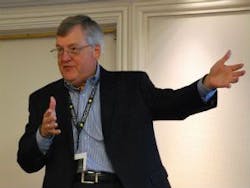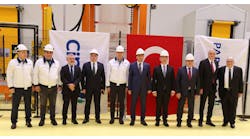“When the last of the software configuration is complete so is the FAT. How beautiful is that?” Timm Madden discussed the many advantages of using Yokogawa’s OpreX Execution methodology on your next automation project.
To hear Timm Madden tell it, instrumentation and controls specialists involved in project execution really had a tough time of it back in the day. They were always on the critical path of project completion, struggling to complete and field test thousands of terminations and lines of code, even as late design changes caused cascades of rework on designs that were to have been “frozen” months before.
If it sounds like the recently retired I&C consultant for ExxonMobil’s upstream operations is talking about the 1970s, he is. But he’s also talking about standard industry best practices less than 10 years ago, when industry first began to roll out a range of new technologies that today are enabling a new era in the execution of automation projects.
Change orders “were my problem forever,” Madden admitted in a presentation this week at the Yokogawa Users Conference in Orlando. And despite the best efforts of his project engineering organization to keep automation off the critical path, it wasn’t until they got their automation system suppliers involved that a solution in the form of new technology combined with new work processes began to take shape.
Yokogawa’s solution, in particular, flies under the company’s OpreX Execution banner and features such innovations as I/O modules that are software configurable on a single-channel basis, standard field junction boxes, and a collaborative, cloud-based engineering and test environment.
The net effect of these technologies is to decouple software and hardware design processes. Control system hardware can be ordered and installed based on an approximate I/O count, even as software development and testing continues on a parallel path. It’s this decoupling that allows the graceful accommodation of late design changes and keeps automation off the critical project path.
Configurable I/O to the field
The development of fully configurable I/O, in particular, means the elimination of marshalling cabinets along with associated engineering and documentation tasks. This effectively reduces by two-thirds the number of field terminations required. “That one change alone is worth a ton of time and money,” Madden said.
Moving the I/O itself out of conditioned space in the control room and out into standard, off-the-shelf field junction boxes is another key step. “To take full advantage, one needs to be willing to install I/O cabinets in the field,” Madden said. “And today’s cabinets are built to survive just fine.” This also means that fewer, smaller wires have to be run back to the control room. Simplified instrument wiring also means that custom loop diagrams give way to a handful of templates instead. And because the hardware is no longer based on custom specifications, most aspects of a traditional hardware factory acceptance test (FAT) are eliminated as well.
Meanwhile, a collaborative, cloud-enabled engineering environment allows the testing and validation of system software to be done in the form of a “continuous” FAT as it becomes available. Code is tested against a virtualized control system, and “when the last of the software configuration is complete so is the FAT,” Madden said. “How beautiful is that?”
Another solution key to both increasing engineering efficiency and minimizing errors is Yokogawa’s iDefine tool, which automatically generates programming for the company’s ProSafe-RS SIS platform based on validated cause-and-effects (C&Es) tables developed in the course of HAZOPS analysis.
“Once we have validated C&Es, we can generate 80% of the safety system programming automatically,” Madden said. “We save time and reduce errors and, again, SIS programming can be tested and validated as part of a continuous FAT. As a result, fewer errors are likely to emerge when it comes time for the initial proof test.”
“In short, Yokogawa’s OpreX Execution model is allowing faster project execution, lower installed costs, better quality documentation that is easier to maintain, and fewer spare parts requirements—all with no sacrifice in system quality,” Madden said. “There are so many advantages, that it’s a no-brainer. You spend less money and come out ahead.”






